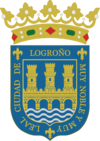Logroño
| Logroño | |||
|---|---|---|---|
 |
|||
|
|||
| Location of Logroño within La Rioja | |||
| Coordinates: 42°27′54″N 2°26′44″W / 42.46500°N 2.44556°WCoordinates: 42°27′54″N 2°26′44″W / 42.46500°N 2.44556°W | |||
| Country | Spain | ||
| Autonomous community | La Rioja | ||
| Comarca | Rioja Media | ||
| Government | |||
| • Mayor | Concepción Gamarra (PP) | ||
| Area | |||
| • City | 79.57 km2 (30.72 sq mi) | ||
| Elevation | 384 m (1,260 ft) | ||
| Population (2008) | |||
| • City | 153,736 | ||
| • Density | 1,900/km2 (5,000/sq mi) | ||
| • Metro | 197,000 | ||
| Time zone | CET (UTC+1) | ||
| • Summer (DST) | CET (UTC+2) | ||
| Website | http://www.logro-o.org | ||
| 336 km (209 mi) to Madrid; Fuero given in 1095 | |||
Logroño (Spanish pronunciation: [loˈɣɾoɲo]) is a city in northern Spain, on the Ebro River. It is the capital of the province of La Rioja.
The population of the city in 2008 was 153,736 while the metropolitan area included nearly 197,000 inhabitants. The city is a centre of the trade in Rioja wine, for which the area is noted, and produces wood, metal and textile products.
Logroño is located in the northern region of La Rioja, on the river Ebro, 384 metres (1,260 feet) above sea level. The Camino de Santiago passes through the city. The geographical coordinates of the city are: 42° 27′ N, 2° 29′ W.
The city lies 152 km (94 mi) from Bilbao, 172 km (107 mi) from Zaragoza, 336 km (209 mi) from Madrid and 468 km (291 mi) from Barcelona.
The weather in Logroño —mostly due to its peculiar location, both in terms of distance to the Atlantic coast and in the situation along the course of the Ebro river, is characterized by values ranging from those typically found in temperate oceanic climates to the warmer and drier ones observed in southeastern mediterranean regions of the river's valley. The average annual temperature is 13.9 °C (57 °F). Although much infrequent, unusually low temperatures during the winter can drop to −5 °C (23 °F), and as low as −10 °C (14 °F); while daily high averages may exceptionally exceed the mark of 35 °C (95 °F) in a particularly hot summer. The average annual precipitation is about 400 mm (15.75 in), regularly spread over the whole year: from 20 mm (0.79 in)–25 mm (0.98 in) in drier periods to the 45 mm (1.77 in)-50 mm (1.97 in) range in the rainiest.
...
Wikipedia



